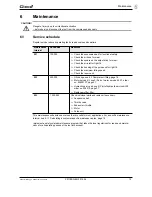
2123b_1_5_en_ bedingt.fm, 03.07.2014
P2119BA/EN 2014-06
13
Troubleshooting
5
4.4.3
Measuring the torque
We recommend carrying out a static torque measurement by retightening the screwed joint.
When carrying out a dynamic measurement using a transducer adapter, also carry out a static test on the
screwed joint, for example with a torque wrench (electronic).
5
Troubleshooting
Error
Possible causes
Measures and remedies
Tool
does not switch off
Torque set too high
Reduce the torque setting, see
Abb. 4-1 , page 11
Pulse count set too low
Increase pulse count, see 4.4.2
Change pulse count, page 12
Working pressure < 400 kPa
Check the cross section of the
hose and coupling: Inner
diameter 3/8" (ø 9.5 mm), maxi-
mum length 5 m
Increase the working pressure.
Reverse button is
not at the detent
Turn the reverse button
to the detent
Excessive transmission damping due
to extension and worn socket.
Use a shorter or more rigid exten-
sion.
Replace the socket
Insufficient oil in the pulse unit (no
pulse build-up)
See 6.2 Fill reserve oil, page 16
If X = 0 (see picture 2), the reserve
oil is exhausted and must be
refilled to guarantee a controlled
process., page 16
Screen in the air inlet tube /
muffler is dirty
Clean or replace parts
Insufficient shut-off
accuracy
Pulse count too low: <6
Increase pulse count,
pulse count > 6
Adapter parts
Replace adapter parts
Use extension and socket with
guide diameter
Pressure fluctuations in the air network
Use a pressure regulator
Fastening time too
long: > 4 seconds
Joint too soft; crush nuts, self-tapping
screws
Use a pulse nutsetter with higher
capacity. Use next tool size.
Use a mechanical screwdriver














































